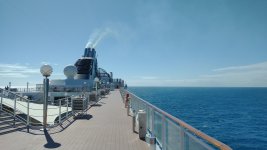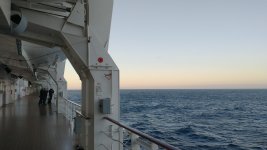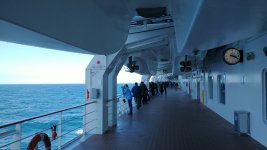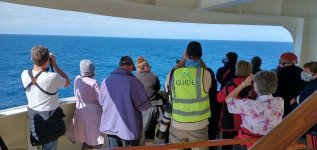27 January. Flock of Marion, Day Four.
5.00 am, position 46°01'26.3"S 36°18'28.9"E, approximately 2000 km south-west of Cape Town, 150 km from the Prince Edward Islands, water depth 2900 m, water temperature 19 C. Surrounded by multiple Wandering Albatrosses and several Sooty Albatrosses and Indian Yellow-nosed Albatrosses, it was a sight to see. Numerous White-chinned Petrels and Great-winged Petrels too, plus a couple of White-headed Petrels and one Brown Skua. And this was just the start - in seas chockablock with birds, the whole day was unbelievable - from dawn till dusk, nonstop Wandering Albatrosses on view, often ten or twenty at a time, and many dozens hyper-elegant Sooty Albatrosses. As we headed for the Prince Edward Islands, it was a dizzying array of birds, I was simply left in awe - as well as the albatrosses, Soft-plumaged Petrels galore, streams of Salvin's Prions and a few less common species too, more notably a Blue Petrel and a White-headed Petrel.
At 10.00 am, the rising rock stacks of Prince Edward lay visible 12 nautical miles to our portside. Water depth 2000 m, water temperature had dropped to 12 C, we were now in penguin territory ...and indeed soon the shout went out, 'penguin to the side of the boat'. Porpoising away, one Macaroni Penguin, magical. The ripple of excitement across the boat for the next hour or so was palpable as calls of birds just echoed across the deck, numerous more Macaroni Penguins, some in flocks of up to eight, two simply superb Pale-mantled Sooty Albatrosses, a Grey-headed Albatross, many Black-bellied Storm Petrels and several Grey-backed Storm Petrels. Among the many Salvin's Prions, several shouts of Fairy Prions too, these usually needing photographic evidence to confirm ...it would be afternoon however before I got to see one. In the meantime though, royalty on the waters - after quite a number of Macaroni Penguins, a pod of six King Penguins sitting on the sea, diving then resurfacing in all their yellow and black glory, truly one of the highlights of the day.
Our route took us on the 12 nautical mile line around the two islands, slowly skirting the east of Prince Edward and Marion Island, looping south and then up the western side. Permission to go closer than 12 nautical miles had been denied, thereby chances of Crozet Shag, Kerguelen Tern, and Lesser Sheathbill were effectively zero, but this did not detract from the experience - we were waters almost never visited by people and just a handful of kilometres from the breeding grounds of 350,000 assorted pairs of penguins and 7000 pairs of albatrosses.
Throughout the day, as well as the never ending mass of Wandering and Sooty Albatrosses , there were also a regular sprinkling of Indian Yellow-nosed Albatrosses, a couple more Grey-headed Albatrosses and, remarkably, another four Pale-mantled Sooty Albatrosses. Through the afternoon, several more Brown Skuas, numerous Black-bellied Storm Petrels, a few Grey-backed Storm Petrels, three identifiable Common Diving-Petrels (and several unidentifiable, perhaps South Georgian) and, on the penguin front, simply superb stuff with the day's personal tally rising to about 25 King Penguins, 60 Macaroni Penguins and three Southern Rockhopper Penguins. Somewhere in the midst of this, two Blue Whales surfaced on the opposite side of the boat, though I do have to confess I was too engrossed in a bunch of King Penguins and did not cross to see them!
Rounding the southern side of Marion, by now past 4 pm, it was time for the 'roaring 40s' to remind of their presence - winds suddenly whipping up, overcast skies throwing in some drizzle. In almost no time at all, winds of 90-100 km/hr were adding considerable chop to the seas. Magical, this was albatross weather - as we on deck huddled for shelter, Wandering Albatrosses played the winds and waves to perfection, great soaring arcs, often towering above the boat. Salvin's Prions and Black-bellied Storm Petrels seemed not to notice the winds at all, Soft-plumaged Petrels simply went bonkers, rising off the waves in great looping arcs high into the sky.
And so ended a most memorable birding day












